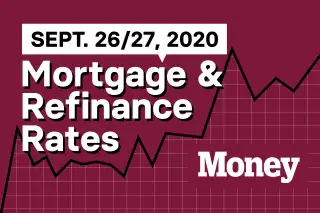Today’s Mortgage and Refinance Rates for September 26th and 27th

Borrowers with 700 credit scores were quoted an average rate of 3.578% to secure a 30-year fixed-rate purchase mortgage on Thursday, according to Money's most recent survey of over 8,000 lenders across the United States. At this credit score, roughly the national average, the rate for a 30-year refinance was 4.494%. Our rates include discount points and are for borrowers putting 20% down.
| 30-year fixed-rate purchase mortgage |
| 3.578% |
| Rate of September 24, 2020 |
Borrowers in Illinois were quoted the lowest mortgage rates on Thursday—at 3.402%. Those in Texas saw the highest average rate at 3.83%. Nationwide, borrowers with the highest credit scores, 740 and above, were quoted rates averaging 3.123%, while those with credit of 640 or below were given rates of 4.78%—a 1.657 percentage point spread.
You may be able to negotiate a lower rate if you shop around or if you have other accounts with the lender. (Money's picks for the best mortgage lenders are here.) Currently, some banks are hiking up advertised rates to keep demand in check, so you may be offered a lower rate if you reach out directly.
Freddie Mac's widely quoted Primary Mortgage Market Survey put rates at 2.90% with 0.8 points paid for the week ending September 24. The mortgage purchaser's weekly survey reflects borrowers who put 20% down on conforming loans and have excellent credit.
Refinance rates
Money's most recent survey also shows that the offered rate for a 30 year refinance for someone with a 740 credit score was 3.81% on Thursday. Last September, the average mortgage rate (including fees) was 3.922%.
| 30-year fixed-rate mortgage refi |
| 3.81% |
| Rate of September 24, 2020 |
A homeowner with a $200,000 mortgage balance currently paying 3.922% on a 30-year loan could potentially cut their monthly payment from $946 to $933 by financing at today's lower rates. To determine if it's worth it to refinance your mortgage, also consider the closing fees you paid on your current mortgage, how much your new lender is charging and how long you have left on your loan term. (Our picks for the best lenders for refinancing are here).
The Housing Week in Review
The past week saw mostly positive housing market news once again, as buyers remained active despite the lingering effects of the COVID-19 pandemic.
Homeowners's equity increased 6.6% year-over-year during the second quarter of 2020, according to a report by CoreLogic. Overall, the total market gained $620 billion in home equity — or $9,800 per homeowner on average. At the same time, the number of mortgages that were underwater — where the borrowers owe more than the house is worth — decreased by 15% to 1.7 million properties.
Homeowners and buyers continued to take advantage of low interest rates, with the volume of mortgage loan applications increased by 6.8% week-over-week. Purchase loan applications were up 3% while refinance applications increased by 9%, according to the Mortgage Bankers Association. Both remained well above year-ago levels, increasing 25% and 86% respectively.
The MBA also reported that the number of homeowners in forbearance programs decreased to 6.93% of all mortgage loans, dipping below 7% for the first time since April. Decreases were logged in all loan types except those backed by Ginnie Mae (meaning FHA and VA loans), which saw an increase not only in the number of loans in the plans but also in the number of new forbearance requests.
Home sales continue to be strong, as existing home sales reached an annually adjusted rate of 6 million units in August. According to a report by the National Association of Realtors, year-over-year sales were up 10.5% and hit their highest level since December of 2006. Double-digit gains were seen across all four surveyed regions. The rush to purchase homes coupled with an already tight housing inventory has led to an increase of 11.4% in the median existing-home price, rising from $278,800 in August of last year to $310,600.
New home sales are also showing growth, as new residential sales for the month of August increased by 4.8% month-over-month to an annually adjusted rate of 1.011 million homes, according to the U.S. Census Bureau. This represents a 43% increase over last August and 15% growth since January, according to the National Association of Home Builders.
While home sales have rebounded nicely since the pandemic caused widespread lockdowns, the lack of housing supply could put the brakes on the housing market boom. According to NAR, total housing inventory is down 18.6% from August of last year. At the current pace of sales, there is just a 3-month supply of unsold inventory on the market.
Since mid-March, when the pandemic-related lockdowns began, there have been nearly 400,000 fewer homes listed for sale than during the same period last year, according to a report by Realtor.com. This represents a 39% decrease in the number of homes listed. New listings hitting the market this week were down 15% from the same week last year.
The lack of inventory, coupled with continued home buyer demand and low interest rates, has led to a continued rise in home prices. Median listing prices increased by 11.1% year-over-year, more than double the rate of growth seen in January of this year. The pace of sales has also increased, with homes selling 12 days faster than a year ago.
Bottom line:
Mortgage Rates Vary From State to State. Here’s How to Get the Best Deal if You’re Moving
Procrastinators, It’s Not Too Late to Refinance Your Mortgage and Save Thousands
Everyone Wants to Buy a House Right Now. 9 Experts Predict How Long Demand Will Soar